Hospitality Consumer Behaviour & Digital Impact: Ritz London
VerifiedAdded on 2023/06/12
|15
|4292
|212
Report
AI Summary
This report delves into hospitality consumer behaviour and insight, using Ritz London as a case study. It investigates cultural, personal, social, and psychological factors influencing consumer behaviour and attitudes. The report explores the impact of digital technology on changing consumer trends, examines the consumer decision-making journey, and maps the path to purchase within the hospitality industry. It compares and contrasts B2C and B2B decision-making processes in hospitality, evaluates market share research approaches, and assesses methods for understanding decision-making. Finally, it evaluates how marketers influence consumer decision-making and respond to the decision-making process, providing relevant examples from the hospitality industry. Desklib is your go-to resource for more solved assignments and past papers.
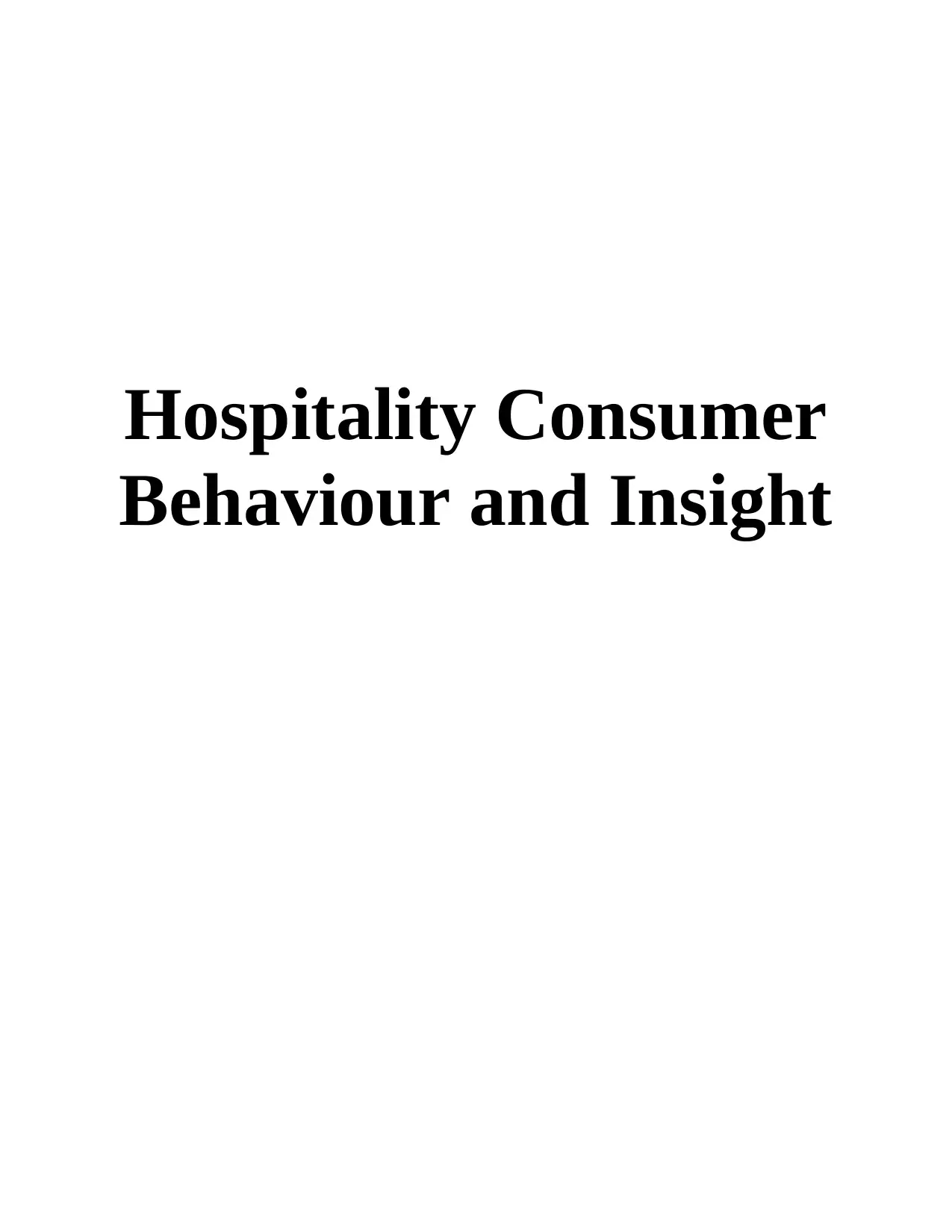
Hospitality Consumer
Behaviour and Insight
Behaviour and Insight
Paraphrase This Document
Need a fresh take? Get an instant paraphrase of this document with our AI Paraphraser
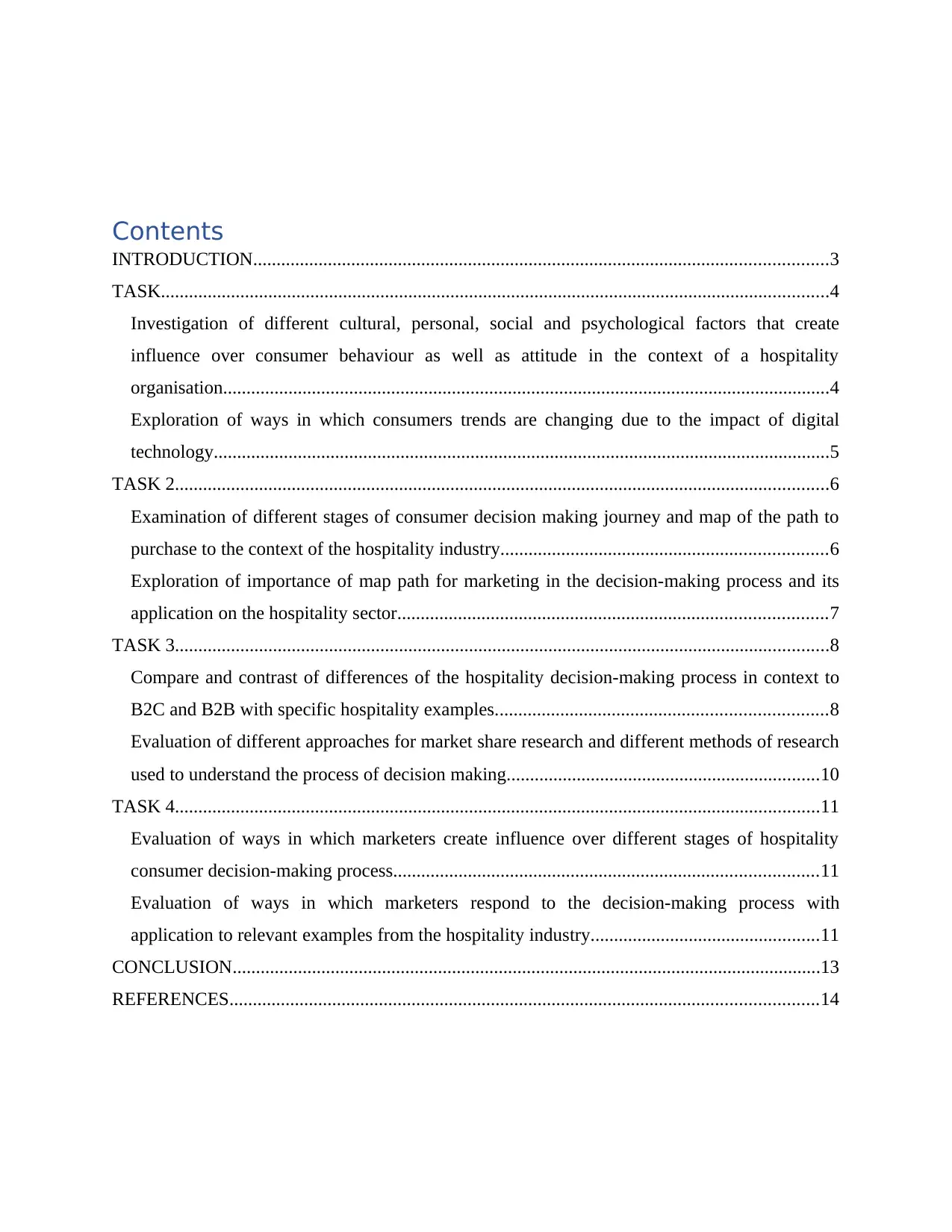
Contents
INTRODUCTION...........................................................................................................................3
TASK...............................................................................................................................................4
Investigation of different cultural, personal, social and psychological factors that create
influence over consumer behaviour as well as attitude in the context of a hospitality
organisation..................................................................................................................................4
Exploration of ways in which consumers trends are changing due to the impact of digital
technology....................................................................................................................................5
TASK 2............................................................................................................................................6
Examination of different stages of consumer decision making journey and map of the path to
purchase to the context of the hospitality industry......................................................................6
Exploration of importance of map path for marketing in the decision-making process and its
application on the hospitality sector............................................................................................7
TASK 3............................................................................................................................................8
Compare and contrast of differences of the hospitality decision-making process in context to
B2C and B2B with specific hospitality examples.......................................................................8
Evaluation of different approaches for market share research and different methods of research
used to understand the process of decision making...................................................................10
TASK 4..........................................................................................................................................11
Evaluation of ways in which marketers create influence over different stages of hospitality
consumer decision-making process...........................................................................................11
Evaluation of ways in which marketers respond to the decision-making process with
application to relevant examples from the hospitality industry.................................................11
CONCLUSION..............................................................................................................................13
REFERENCES..............................................................................................................................14
INTRODUCTION...........................................................................................................................3
TASK...............................................................................................................................................4
Investigation of different cultural, personal, social and psychological factors that create
influence over consumer behaviour as well as attitude in the context of a hospitality
organisation..................................................................................................................................4
Exploration of ways in which consumers trends are changing due to the impact of digital
technology....................................................................................................................................5
TASK 2............................................................................................................................................6
Examination of different stages of consumer decision making journey and map of the path to
purchase to the context of the hospitality industry......................................................................6
Exploration of importance of map path for marketing in the decision-making process and its
application on the hospitality sector............................................................................................7
TASK 3............................................................................................................................................8
Compare and contrast of differences of the hospitality decision-making process in context to
B2C and B2B with specific hospitality examples.......................................................................8
Evaluation of different approaches for market share research and different methods of research
used to understand the process of decision making...................................................................10
TASK 4..........................................................................................................................................11
Evaluation of ways in which marketers create influence over different stages of hospitality
consumer decision-making process...........................................................................................11
Evaluation of ways in which marketers respond to the decision-making process with
application to relevant examples from the hospitality industry.................................................11
CONCLUSION..............................................................................................................................13
REFERENCES..............................................................................................................................14
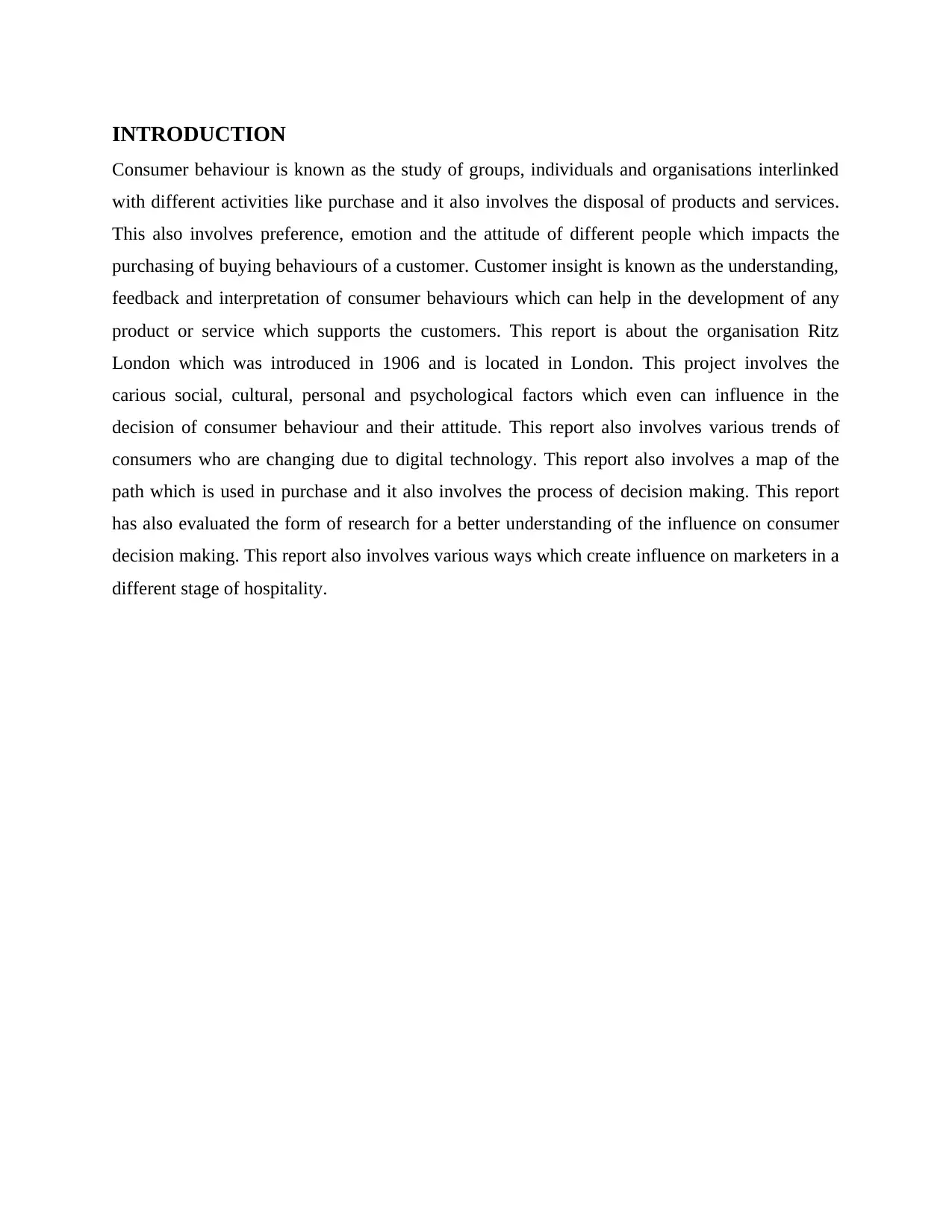
INTRODUCTION
Consumer behaviour is known as the study of groups, individuals and organisations interlinked
with different activities like purchase and it also involves the disposal of products and services.
This also involves preference, emotion and the attitude of different people which impacts the
purchasing of buying behaviours of a customer. Customer insight is known as the understanding,
feedback and interpretation of consumer behaviours which can help in the development of any
product or service which supports the customers. This report is about the organisation Ritz
London which was introduced in 1906 and is located in London. This project involves the
carious social, cultural, personal and psychological factors which even can influence in the
decision of consumer behaviour and their attitude. This report also involves various trends of
consumers who are changing due to digital technology. This report also involves a map of the
path which is used in purchase and it also involves the process of decision making. This report
has also evaluated the form of research for a better understanding of the influence on consumer
decision making. This report also involves various ways which create influence on marketers in a
different stage of hospitality.
Consumer behaviour is known as the study of groups, individuals and organisations interlinked
with different activities like purchase and it also involves the disposal of products and services.
This also involves preference, emotion and the attitude of different people which impacts the
purchasing of buying behaviours of a customer. Customer insight is known as the understanding,
feedback and interpretation of consumer behaviours which can help in the development of any
product or service which supports the customers. This report is about the organisation Ritz
London which was introduced in 1906 and is located in London. This project involves the
carious social, cultural, personal and psychological factors which even can influence in the
decision of consumer behaviour and their attitude. This report also involves various trends of
consumers who are changing due to digital technology. This report also involves a map of the
path which is used in purchase and it also involves the process of decision making. This report
has also evaluated the form of research for a better understanding of the influence on consumer
decision making. This report also involves various ways which create influence on marketers in a
different stage of hospitality.
⊘ This is a preview!⊘
Do you want full access?
Subscribe today to unlock all pages.

Trusted by 1+ million students worldwide
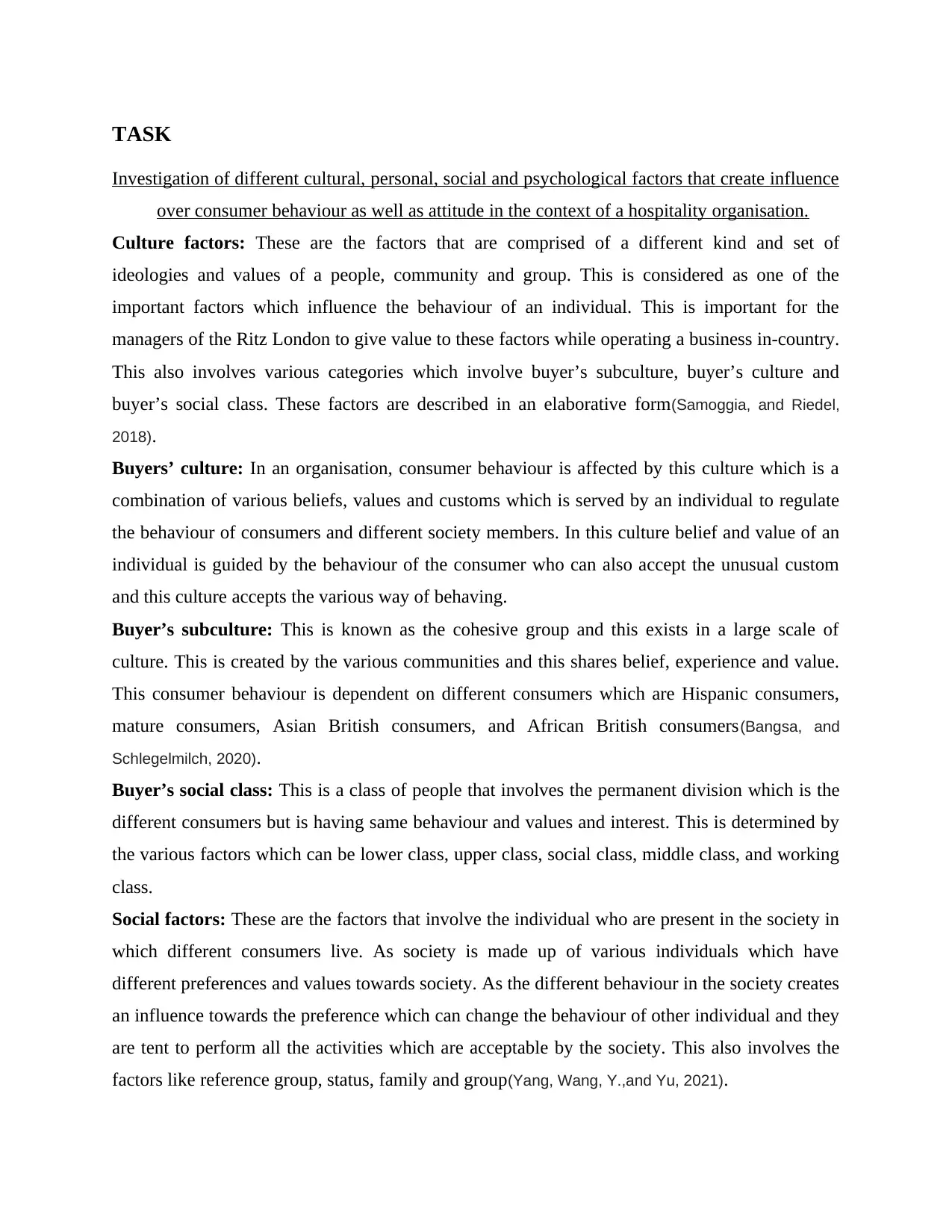
TASK
Investigation of different cultural, personal, social and psychological factors that create influence
over consumer behaviour as well as attitude in the context of a hospitality organisation.
Culture factors: These are the factors that are comprised of a different kind and set of
ideologies and values of a people, community and group. This is considered as one of the
important factors which influence the behaviour of an individual. This is important for the
managers of the Ritz London to give value to these factors while operating a business in-country.
This also involves various categories which involve buyer’s subculture, buyer’s culture and
buyer’s social class. These factors are described in an elaborative form(Samoggia, and Riedel,
2018).
Buyers’ culture: In an organisation, consumer behaviour is affected by this culture which is a
combination of various beliefs, values and customs which is served by an individual to regulate
the behaviour of consumers and different society members. In this culture belief and value of an
individual is guided by the behaviour of the consumer who can also accept the unusual custom
and this culture accepts the various way of behaving.
Buyer’s subculture: This is known as the cohesive group and this exists in a large scale of
culture. This is created by the various communities and this shares belief, experience and value.
This consumer behaviour is dependent on different consumers which are Hispanic consumers,
mature consumers, Asian British consumers, and African British consumers(Bangsa, and
Schlegelmilch, 2020).
Buyer’s social class: This is a class of people that involves the permanent division which is the
different consumers but is having same behaviour and values and interest. This is determined by
the various factors which can be lower class, upper class, social class, middle class, and working
class.
Social factors: These are the factors that involve the individual who are present in the society in
which different consumers live. As society is made up of various individuals which have
different preferences and values towards society. As the different behaviour in the society creates
an influence towards the preference which can change the behaviour of other individual and they
are tent to perform all the activities which are acceptable by the society. This also involves the
factors like reference group, status, family and group(Yang, Wang, Y.,and Yu, 2021).
Investigation of different cultural, personal, social and psychological factors that create influence
over consumer behaviour as well as attitude in the context of a hospitality organisation.
Culture factors: These are the factors that are comprised of a different kind and set of
ideologies and values of a people, community and group. This is considered as one of the
important factors which influence the behaviour of an individual. This is important for the
managers of the Ritz London to give value to these factors while operating a business in-country.
This also involves various categories which involve buyer’s subculture, buyer’s culture and
buyer’s social class. These factors are described in an elaborative form(Samoggia, and Riedel,
2018).
Buyers’ culture: In an organisation, consumer behaviour is affected by this culture which is a
combination of various beliefs, values and customs which is served by an individual to regulate
the behaviour of consumers and different society members. In this culture belief and value of an
individual is guided by the behaviour of the consumer who can also accept the unusual custom
and this culture accepts the various way of behaving.
Buyer’s subculture: This is known as the cohesive group and this exists in a large scale of
culture. This is created by the various communities and this shares belief, experience and value.
This consumer behaviour is dependent on different consumers which are Hispanic consumers,
mature consumers, Asian British consumers, and African British consumers(Bangsa, and
Schlegelmilch, 2020).
Buyer’s social class: This is a class of people that involves the permanent division which is the
different consumers but is having same behaviour and values and interest. This is determined by
the various factors which can be lower class, upper class, social class, middle class, and working
class.
Social factors: These are the factors that involve the individual who are present in the society in
which different consumers live. As society is made up of various individuals which have
different preferences and values towards society. As the different behaviour in the society creates
an influence towards the preference which can change the behaviour of other individual and they
are tent to perform all the activities which are acceptable by the society. This also involves the
factors like reference group, status, family and group(Yang, Wang, Y.,and Yu, 2021).
Paraphrase This Document
Need a fresh take? Get an instant paraphrase of this document with our AI Paraphraser
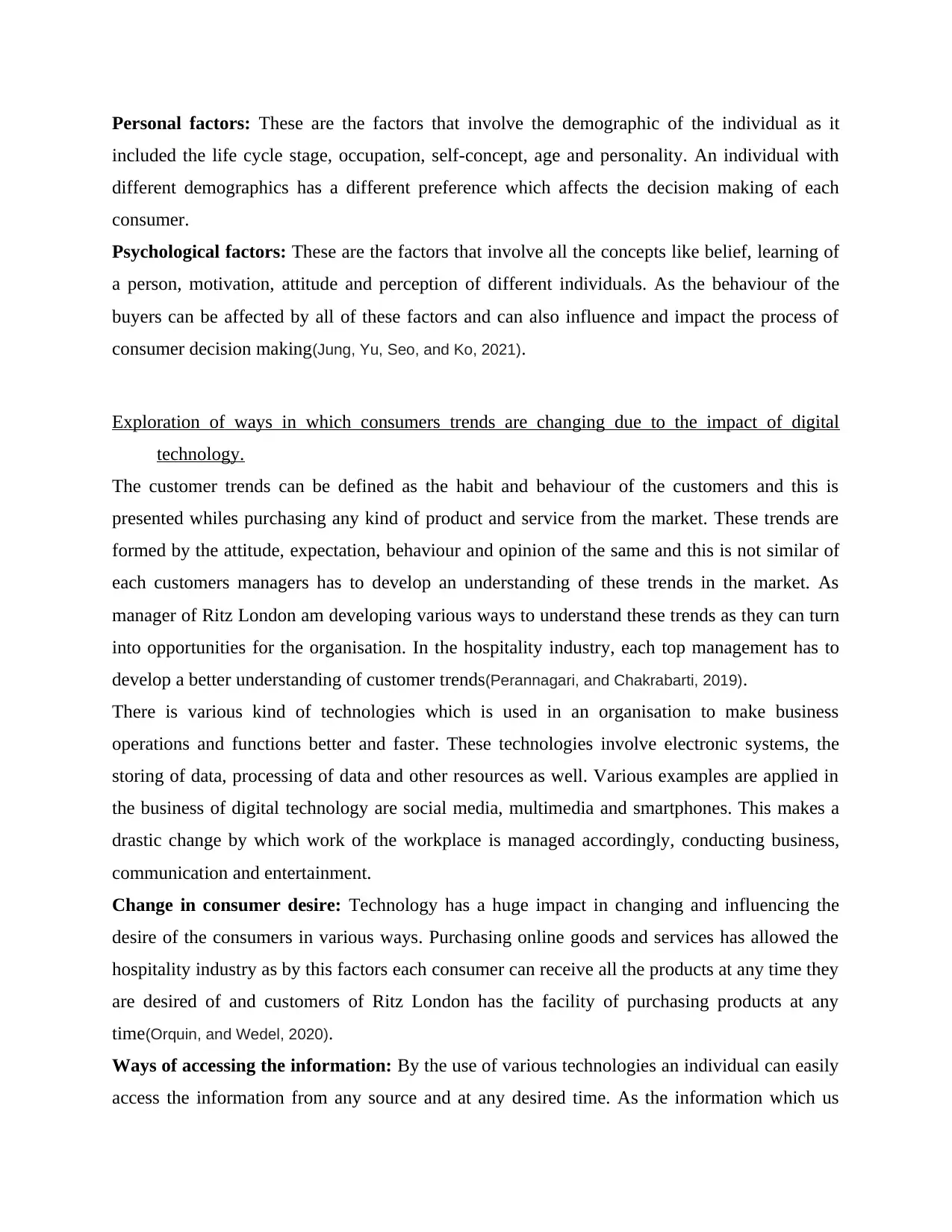
Personal factors: These are the factors that involve the demographic of the individual as it
included the life cycle stage, occupation, self-concept, age and personality. An individual with
different demographics has a different preference which affects the decision making of each
consumer.
Psychological factors: These are the factors that involve all the concepts like belief, learning of
a person, motivation, attitude and perception of different individuals. As the behaviour of the
buyers can be affected by all of these factors and can also influence and impact the process of
consumer decision making(Jung, Yu, Seo, and Ko, 2021).
Exploration of ways in which consumers trends are changing due to the impact of digital
technology.
The customer trends can be defined as the habit and behaviour of the customers and this is
presented whiles purchasing any kind of product and service from the market. These trends are
formed by the attitude, expectation, behaviour and opinion of the same and this is not similar of
each customers managers has to develop an understanding of these trends in the market. As
manager of Ritz London am developing various ways to understand these trends as they can turn
into opportunities for the organisation. In the hospitality industry, each top management has to
develop a better understanding of customer trends(Perannagari, and Chakrabarti, 2019).
There is various kind of technologies which is used in an organisation to make business
operations and functions better and faster. These technologies involve electronic systems, the
storing of data, processing of data and other resources as well. Various examples are applied in
the business of digital technology are social media, multimedia and smartphones. This makes a
drastic change by which work of the workplace is managed accordingly, conducting business,
communication and entertainment.
Change in consumer desire: Technology has a huge impact in changing and influencing the
desire of the consumers in various ways. Purchasing online goods and services has allowed the
hospitality industry as by this factors each consumer can receive all the products at any time they
are desired of and customers of Ritz London has the facility of purchasing products at any
time(Orquin, and Wedel, 2020).
Ways of accessing the information: By the use of various technologies an individual can easily
access the information from any source and at any desired time. As the information which us
included the life cycle stage, occupation, self-concept, age and personality. An individual with
different demographics has a different preference which affects the decision making of each
consumer.
Psychological factors: These are the factors that involve all the concepts like belief, learning of
a person, motivation, attitude and perception of different individuals. As the behaviour of the
buyers can be affected by all of these factors and can also influence and impact the process of
consumer decision making(Jung, Yu, Seo, and Ko, 2021).
Exploration of ways in which consumers trends are changing due to the impact of digital
technology.
The customer trends can be defined as the habit and behaviour of the customers and this is
presented whiles purchasing any kind of product and service from the market. These trends are
formed by the attitude, expectation, behaviour and opinion of the same and this is not similar of
each customers managers has to develop an understanding of these trends in the market. As
manager of Ritz London am developing various ways to understand these trends as they can turn
into opportunities for the organisation. In the hospitality industry, each top management has to
develop a better understanding of customer trends(Perannagari, and Chakrabarti, 2019).
There is various kind of technologies which is used in an organisation to make business
operations and functions better and faster. These technologies involve electronic systems, the
storing of data, processing of data and other resources as well. Various examples are applied in
the business of digital technology are social media, multimedia and smartphones. This makes a
drastic change by which work of the workplace is managed accordingly, conducting business,
communication and entertainment.
Change in consumer desire: Technology has a huge impact in changing and influencing the
desire of the consumers in various ways. Purchasing online goods and services has allowed the
hospitality industry as by this factors each consumer can receive all the products at any time they
are desired of and customers of Ritz London has the facility of purchasing products at any
time(Orquin, and Wedel, 2020).
Ways of accessing the information: By the use of various technologies an individual can easily
access the information from any source and at any desired time. As the information which us
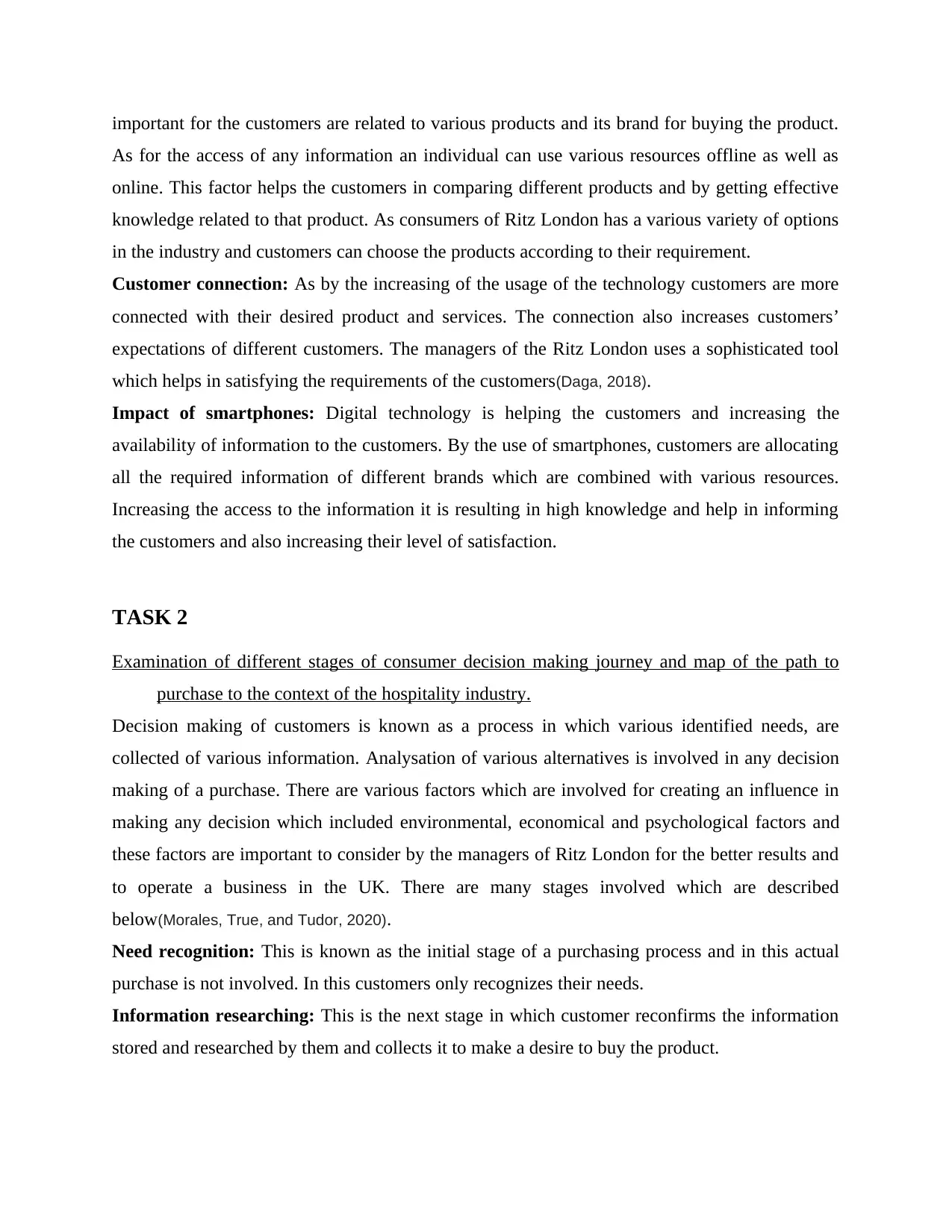
important for the customers are related to various products and its brand for buying the product.
As for the access of any information an individual can use various resources offline as well as
online. This factor helps the customers in comparing different products and by getting effective
knowledge related to that product. As consumers of Ritz London has a various variety of options
in the industry and customers can choose the products according to their requirement.
Customer connection: As by the increasing of the usage of the technology customers are more
connected with their desired product and services. The connection also increases customers’
expectations of different customers. The managers of the Ritz London uses a sophisticated tool
which helps in satisfying the requirements of the customers(Daga, 2018).
Impact of smartphones: Digital technology is helping the customers and increasing the
availability of information to the customers. By the use of smartphones, customers are allocating
all the required information of different brands which are combined with various resources.
Increasing the access to the information it is resulting in high knowledge and help in informing
the customers and also increasing their level of satisfaction.
TASK 2
Examination of different stages of consumer decision making journey and map of the path to
purchase to the context of the hospitality industry.
Decision making of customers is known as a process in which various identified needs, are
collected of various information. Analysation of various alternatives is involved in any decision
making of a purchase. There are various factors which are involved for creating an influence in
making any decision which included environmental, economical and psychological factors and
these factors are important to consider by the managers of Ritz London for the better results and
to operate a business in the UK. There are many stages involved which are described
below(Morales, True, and Tudor, 2020).
Need recognition: This is known as the initial stage of a purchasing process and in this actual
purchase is not involved. In this customers only recognizes their needs.
Information researching: This is the next stage in which customer reconfirms the information
stored and researched by them and collects it to make a desire to buy the product.
As for the access of any information an individual can use various resources offline as well as
online. This factor helps the customers in comparing different products and by getting effective
knowledge related to that product. As consumers of Ritz London has a various variety of options
in the industry and customers can choose the products according to their requirement.
Customer connection: As by the increasing of the usage of the technology customers are more
connected with their desired product and services. The connection also increases customers’
expectations of different customers. The managers of the Ritz London uses a sophisticated tool
which helps in satisfying the requirements of the customers(Daga, 2018).
Impact of smartphones: Digital technology is helping the customers and increasing the
availability of information to the customers. By the use of smartphones, customers are allocating
all the required information of different brands which are combined with various resources.
Increasing the access to the information it is resulting in high knowledge and help in informing
the customers and also increasing their level of satisfaction.
TASK 2
Examination of different stages of consumer decision making journey and map of the path to
purchase to the context of the hospitality industry.
Decision making of customers is known as a process in which various identified needs, are
collected of various information. Analysation of various alternatives is involved in any decision
making of a purchase. There are various factors which are involved for creating an influence in
making any decision which included environmental, economical and psychological factors and
these factors are important to consider by the managers of Ritz London for the better results and
to operate a business in the UK. There are many stages involved which are described
below(Morales, True, and Tudor, 2020).
Need recognition: This is known as the initial stage of a purchasing process and in this actual
purchase is not involved. In this customers only recognizes their needs.
Information researching: This is the next stage in which customer reconfirms the information
stored and researched by them and collects it to make a desire to buy the product.
⊘ This is a preview!⊘
Do you want full access?
Subscribe today to unlock all pages.

Trusted by 1+ million students worldwide
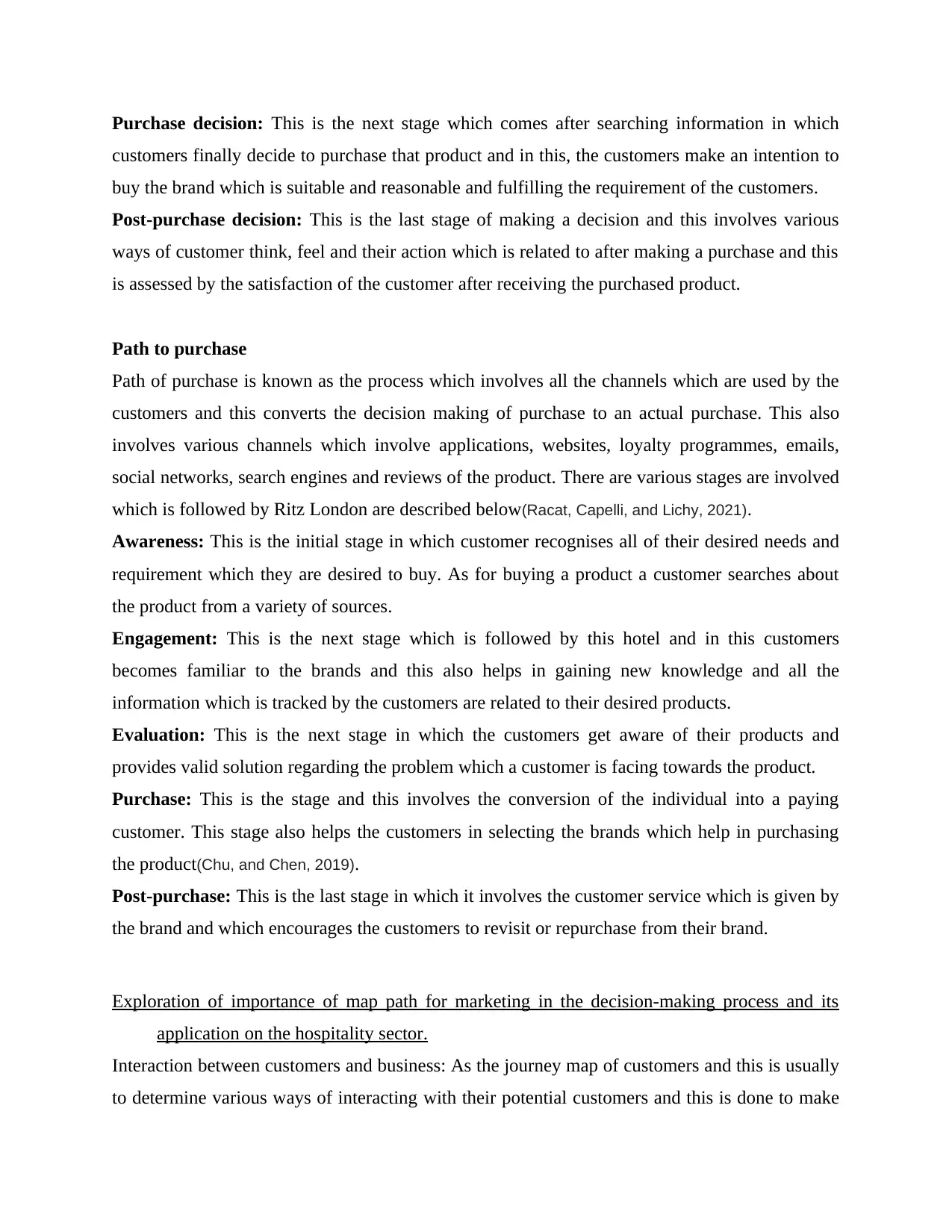
Purchase decision: This is the next stage which comes after searching information in which
customers finally decide to purchase that product and in this, the customers make an intention to
buy the brand which is suitable and reasonable and fulfilling the requirement of the customers.
Post-purchase decision: This is the last stage of making a decision and this involves various
ways of customer think, feel and their action which is related to after making a purchase and this
is assessed by the satisfaction of the customer after receiving the purchased product.
Path to purchase
Path of purchase is known as the process which involves all the channels which are used by the
customers and this converts the decision making of purchase to an actual purchase. This also
involves various channels which involve applications, websites, loyalty programmes, emails,
social networks, search engines and reviews of the product. There are various stages are involved
which is followed by Ritz London are described below(Racat, Capelli, and Lichy, 2021).
Awareness: This is the initial stage in which customer recognises all of their desired needs and
requirement which they are desired to buy. As for buying a product a customer searches about
the product from a variety of sources.
Engagement: This is the next stage which is followed by this hotel and in this customers
becomes familiar to the brands and this also helps in gaining new knowledge and all the
information which is tracked by the customers are related to their desired products.
Evaluation: This is the next stage in which the customers get aware of their products and
provides valid solution regarding the problem which a customer is facing towards the product.
Purchase: This is the stage and this involves the conversion of the individual into a paying
customer. This stage also helps the customers in selecting the brands which help in purchasing
the product(Chu, and Chen, 2019).
Post-purchase: This is the last stage in which it involves the customer service which is given by
the brand and which encourages the customers to revisit or repurchase from their brand.
Exploration of importance of map path for marketing in the decision-making process and its
application on the hospitality sector.
Interaction between customers and business: As the journey map of customers and this is usually
to determine various ways of interacting with their potential customers and this is done to make
customers finally decide to purchase that product and in this, the customers make an intention to
buy the brand which is suitable and reasonable and fulfilling the requirement of the customers.
Post-purchase decision: This is the last stage of making a decision and this involves various
ways of customer think, feel and their action which is related to after making a purchase and this
is assessed by the satisfaction of the customer after receiving the purchased product.
Path to purchase
Path of purchase is known as the process which involves all the channels which are used by the
customers and this converts the decision making of purchase to an actual purchase. This also
involves various channels which involve applications, websites, loyalty programmes, emails,
social networks, search engines and reviews of the product. There are various stages are involved
which is followed by Ritz London are described below(Racat, Capelli, and Lichy, 2021).
Awareness: This is the initial stage in which customer recognises all of their desired needs and
requirement which they are desired to buy. As for buying a product a customer searches about
the product from a variety of sources.
Engagement: This is the next stage which is followed by this hotel and in this customers
becomes familiar to the brands and this also helps in gaining new knowledge and all the
information which is tracked by the customers are related to their desired products.
Evaluation: This is the next stage in which the customers get aware of their products and
provides valid solution regarding the problem which a customer is facing towards the product.
Purchase: This is the stage and this involves the conversion of the individual into a paying
customer. This stage also helps the customers in selecting the brands which help in purchasing
the product(Chu, and Chen, 2019).
Post-purchase: This is the last stage in which it involves the customer service which is given by
the brand and which encourages the customers to revisit or repurchase from their brand.
Exploration of importance of map path for marketing in the decision-making process and its
application on the hospitality sector.
Interaction between customers and business: As the journey map of customers and this is usually
to determine various ways of interacting with their potential customers and this is done to make
Paraphrase This Document
Need a fresh take? Get an instant paraphrase of this document with our AI Paraphraser
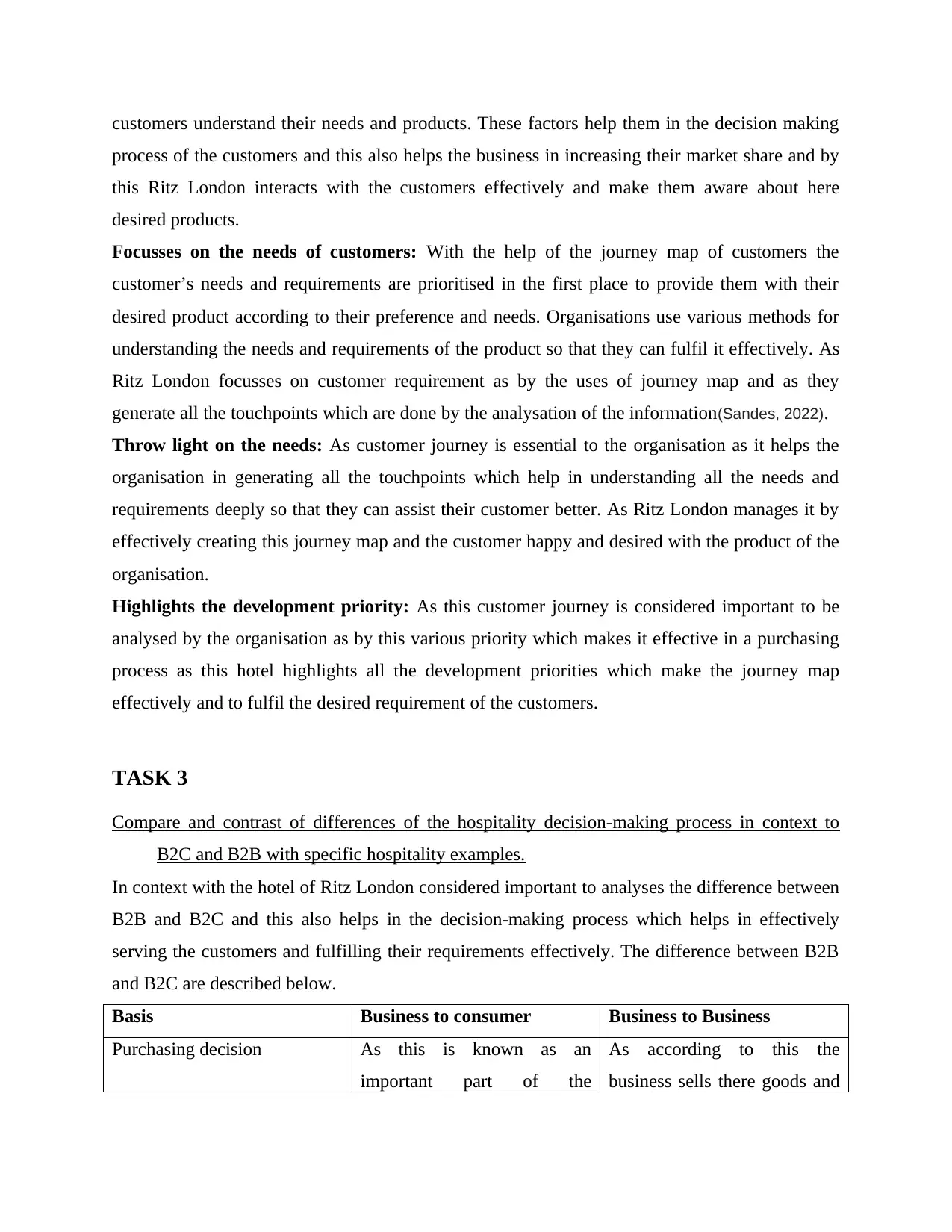
customers understand their needs and products. These factors help them in the decision making
process of the customers and this also helps the business in increasing their market share and by
this Ritz London interacts with the customers effectively and make them aware about here
desired products.
Focusses on the needs of customers: With the help of the journey map of customers the
customer’s needs and requirements are prioritised in the first place to provide them with their
desired product according to their preference and needs. Organisations use various methods for
understanding the needs and requirements of the product so that they can fulfil it effectively. As
Ritz London focusses on customer requirement as by the uses of journey map and as they
generate all the touchpoints which are done by the analysation of the information(Sandes, 2022).
Throw light on the needs: As customer journey is essential to the organisation as it helps the
organisation in generating all the touchpoints which help in understanding all the needs and
requirements deeply so that they can assist their customer better. As Ritz London manages it by
effectively creating this journey map and the customer happy and desired with the product of the
organisation.
Highlights the development priority: As this customer journey is considered important to be
analysed by the organisation as by this various priority which makes it effective in a purchasing
process as this hotel highlights all the development priorities which make the journey map
effectively and to fulfil the desired requirement of the customers.
TASK 3
Compare and contrast of differences of the hospitality decision-making process in context to
B2C and B2B with specific hospitality examples.
In context with the hotel of Ritz London considered important to analyses the difference between
B2B and B2C and this also helps in the decision-making process which helps in effectively
serving the customers and fulfilling their requirements effectively. The difference between B2B
and B2C are described below.
Basis Business to consumer Business to Business
Purchasing decision As this is known as an
important part of the
As according to this the
business sells there goods and
process of the customers and this also helps the business in increasing their market share and by
this Ritz London interacts with the customers effectively and make them aware about here
desired products.
Focusses on the needs of customers: With the help of the journey map of customers the
customer’s needs and requirements are prioritised in the first place to provide them with their
desired product according to their preference and needs. Organisations use various methods for
understanding the needs and requirements of the product so that they can fulfil it effectively. As
Ritz London focusses on customer requirement as by the uses of journey map and as they
generate all the touchpoints which are done by the analysation of the information(Sandes, 2022).
Throw light on the needs: As customer journey is essential to the organisation as it helps the
organisation in generating all the touchpoints which help in understanding all the needs and
requirements deeply so that they can assist their customer better. As Ritz London manages it by
effectively creating this journey map and the customer happy and desired with the product of the
organisation.
Highlights the development priority: As this customer journey is considered important to be
analysed by the organisation as by this various priority which makes it effective in a purchasing
process as this hotel highlights all the development priorities which make the journey map
effectively and to fulfil the desired requirement of the customers.
TASK 3
Compare and contrast of differences of the hospitality decision-making process in context to
B2C and B2B with specific hospitality examples.
In context with the hotel of Ritz London considered important to analyses the difference between
B2B and B2C and this also helps in the decision-making process which helps in effectively
serving the customers and fulfilling their requirements effectively. The difference between B2B
and B2C are described below.
Basis Business to consumer Business to Business
Purchasing decision As this is known as an
important part of the
As according to this the
business sells there goods and
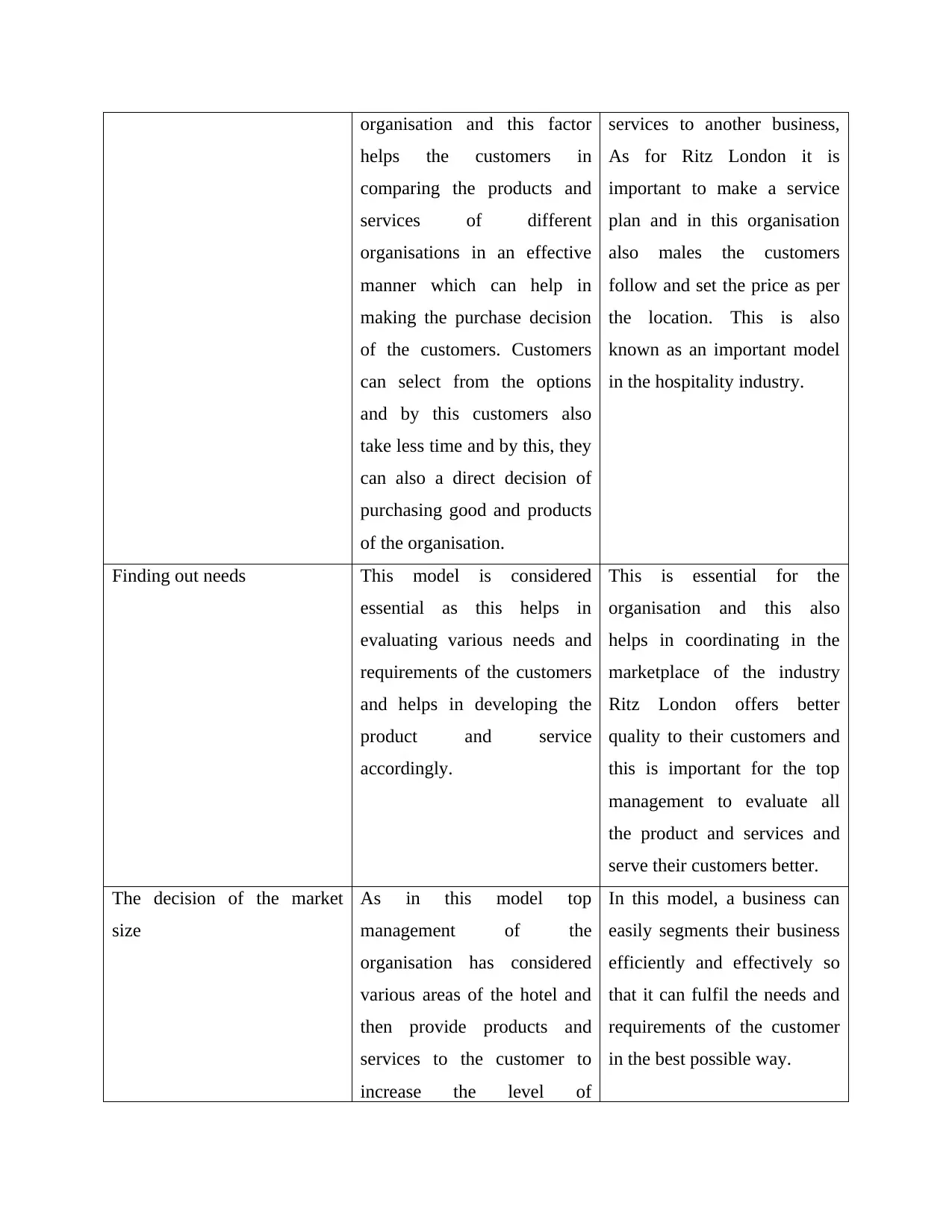
organisation and this factor
helps the customers in
comparing the products and
services of different
organisations in an effective
manner which can help in
making the purchase decision
of the customers. Customers
can select from the options
and by this customers also
take less time and by this, they
can also a direct decision of
purchasing good and products
of the organisation.
services to another business,
As for Ritz London it is
important to make a service
plan and in this organisation
also males the customers
follow and set the price as per
the location. This is also
known as an important model
in the hospitality industry.
Finding out needs This model is considered
essential as this helps in
evaluating various needs and
requirements of the customers
and helps in developing the
product and service
accordingly.
This is essential for the
organisation and this also
helps in coordinating in the
marketplace of the industry
Ritz London offers better
quality to their customers and
this is important for the top
management to evaluate all
the product and services and
serve their customers better.
The decision of the market
size
As in this model top
management of the
organisation has considered
various areas of the hotel and
then provide products and
services to the customer to
increase the level of
In this model, a business can
easily segments their business
efficiently and effectively so
that it can fulfil the needs and
requirements of the customer
in the best possible way.
helps the customers in
comparing the products and
services of different
organisations in an effective
manner which can help in
making the purchase decision
of the customers. Customers
can select from the options
and by this customers also
take less time and by this, they
can also a direct decision of
purchasing good and products
of the organisation.
services to another business,
As for Ritz London it is
important to make a service
plan and in this organisation
also males the customers
follow and set the price as per
the location. This is also
known as an important model
in the hospitality industry.
Finding out needs This model is considered
essential as this helps in
evaluating various needs and
requirements of the customers
and helps in developing the
product and service
accordingly.
This is essential for the
organisation and this also
helps in coordinating in the
marketplace of the industry
Ritz London offers better
quality to their customers and
this is important for the top
management to evaluate all
the product and services and
serve their customers better.
The decision of the market
size
As in this model top
management of the
organisation has considered
various areas of the hotel and
then provide products and
services to the customer to
increase the level of
In this model, a business can
easily segments their business
efficiently and effectively so
that it can fulfil the needs and
requirements of the customer
in the best possible way.
⊘ This is a preview!⊘
Do you want full access?
Subscribe today to unlock all pages.

Trusted by 1+ million students worldwide
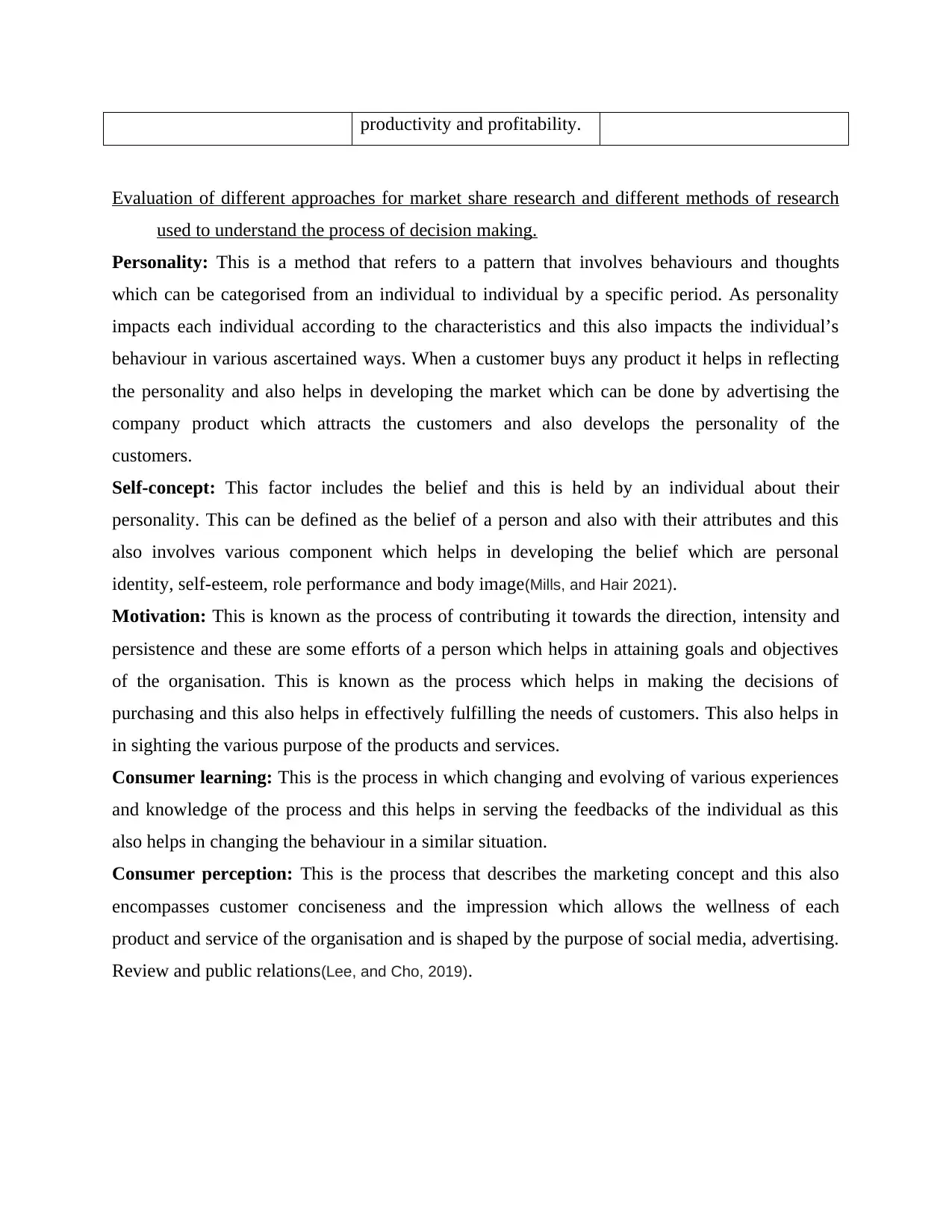
productivity and profitability.
Evaluation of different approaches for market share research and different methods of research
used to understand the process of decision making.
Personality: This is a method that refers to a pattern that involves behaviours and thoughts
which can be categorised from an individual to individual by a specific period. As personality
impacts each individual according to the characteristics and this also impacts the individual’s
behaviour in various ascertained ways. When a customer buys any product it helps in reflecting
the personality and also helps in developing the market which can be done by advertising the
company product which attracts the customers and also develops the personality of the
customers.
Self-concept: This factor includes the belief and this is held by an individual about their
personality. This can be defined as the belief of a person and also with their attributes and this
also involves various component which helps in developing the belief which are personal
identity, self-esteem, role performance and body image(Mills, and Hair 2021).
Motivation: This is known as the process of contributing it towards the direction, intensity and
persistence and these are some efforts of a person which helps in attaining goals and objectives
of the organisation. This is known as the process which helps in making the decisions of
purchasing and this also helps in effectively fulfilling the needs of customers. This also helps in
in sighting the various purpose of the products and services.
Consumer learning: This is the process in which changing and evolving of various experiences
and knowledge of the process and this helps in serving the feedbacks of the individual as this
also helps in changing the behaviour in a similar situation.
Consumer perception: This is the process that describes the marketing concept and this also
encompasses customer conciseness and the impression which allows the wellness of each
product and service of the organisation and is shaped by the purpose of social media, advertising.
Review and public relations(Lee, and Cho, 2019).
Evaluation of different approaches for market share research and different methods of research
used to understand the process of decision making.
Personality: This is a method that refers to a pattern that involves behaviours and thoughts
which can be categorised from an individual to individual by a specific period. As personality
impacts each individual according to the characteristics and this also impacts the individual’s
behaviour in various ascertained ways. When a customer buys any product it helps in reflecting
the personality and also helps in developing the market which can be done by advertising the
company product which attracts the customers and also develops the personality of the
customers.
Self-concept: This factor includes the belief and this is held by an individual about their
personality. This can be defined as the belief of a person and also with their attributes and this
also involves various component which helps in developing the belief which are personal
identity, self-esteem, role performance and body image(Mills, and Hair 2021).
Motivation: This is known as the process of contributing it towards the direction, intensity and
persistence and these are some efforts of a person which helps in attaining goals and objectives
of the organisation. This is known as the process which helps in making the decisions of
purchasing and this also helps in effectively fulfilling the needs of customers. This also helps in
in sighting the various purpose of the products and services.
Consumer learning: This is the process in which changing and evolving of various experiences
and knowledge of the process and this helps in serving the feedbacks of the individual as this
also helps in changing the behaviour in a similar situation.
Consumer perception: This is the process that describes the marketing concept and this also
encompasses customer conciseness and the impression which allows the wellness of each
product and service of the organisation and is shaped by the purpose of social media, advertising.
Review and public relations(Lee, and Cho, 2019).
Paraphrase This Document
Need a fresh take? Get an instant paraphrase of this document with our AI Paraphraser
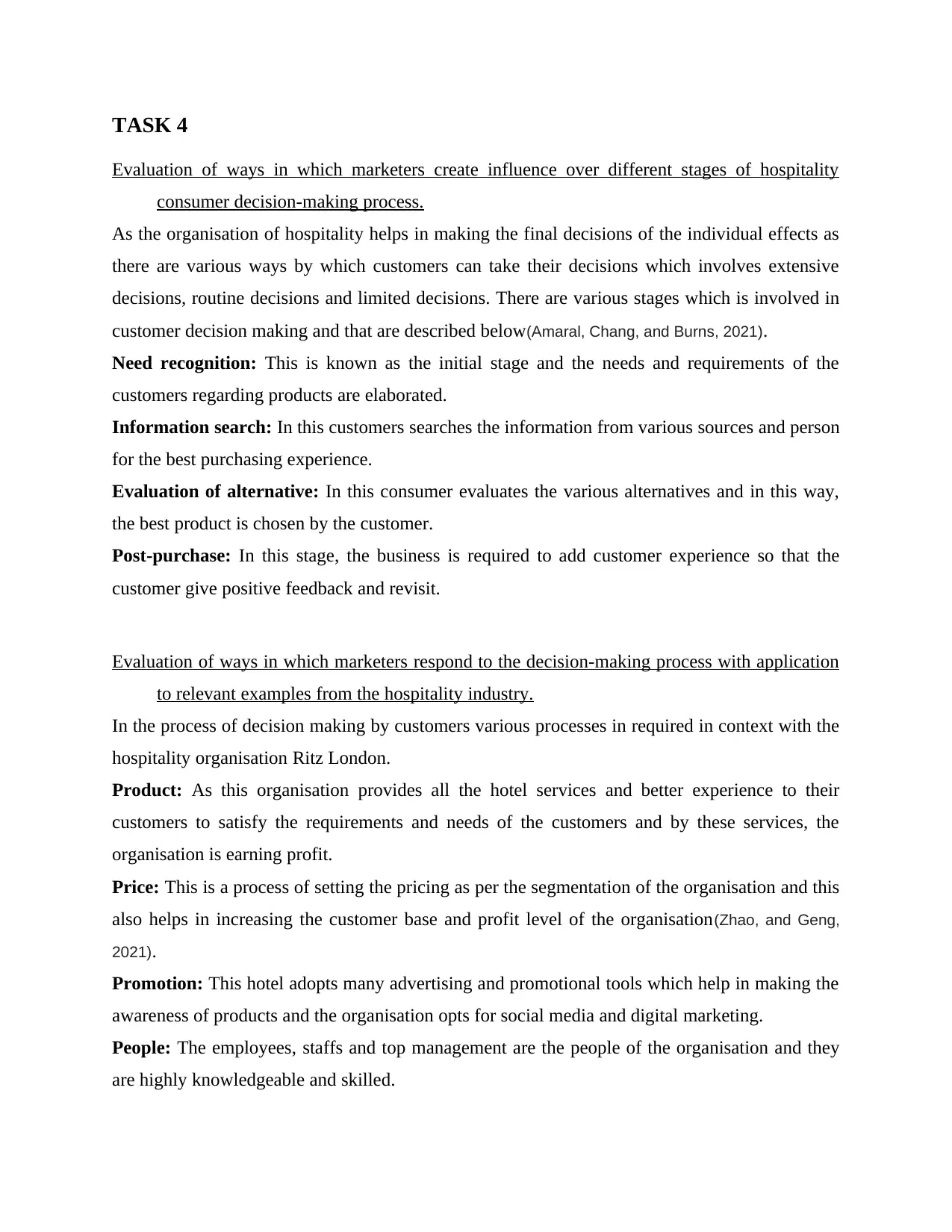
TASK 4
Evaluation of ways in which marketers create influence over different stages of hospitality
consumer decision-making process.
As the organisation of hospitality helps in making the final decisions of the individual effects as
there are various ways by which customers can take their decisions which involves extensive
decisions, routine decisions and limited decisions. There are various stages which is involved in
customer decision making and that are described below(Amaral, Chang, and Burns, 2021).
Need recognition: This is known as the initial stage and the needs and requirements of the
customers regarding products are elaborated.
Information search: In this customers searches the information from various sources and person
for the best purchasing experience.
Evaluation of alternative: In this consumer evaluates the various alternatives and in this way,
the best product is chosen by the customer.
Post-purchase: In this stage, the business is required to add customer experience so that the
customer give positive feedback and revisit.
Evaluation of ways in which marketers respond to the decision-making process with application
to relevant examples from the hospitality industry.
In the process of decision making by customers various processes in required in context with the
hospitality organisation Ritz London.
Product: As this organisation provides all the hotel services and better experience to their
customers to satisfy the requirements and needs of the customers and by these services, the
organisation is earning profit.
Price: This is a process of setting the pricing as per the segmentation of the organisation and this
also helps in increasing the customer base and profit level of the organisation(Zhao, and Geng,
2021).
Promotion: This hotel adopts many advertising and promotional tools which help in making the
awareness of products and the organisation opts for social media and digital marketing.
People: The employees, staffs and top management are the people of the organisation and they
are highly knowledgeable and skilled.
Evaluation of ways in which marketers create influence over different stages of hospitality
consumer decision-making process.
As the organisation of hospitality helps in making the final decisions of the individual effects as
there are various ways by which customers can take their decisions which involves extensive
decisions, routine decisions and limited decisions. There are various stages which is involved in
customer decision making and that are described below(Amaral, Chang, and Burns, 2021).
Need recognition: This is known as the initial stage and the needs and requirements of the
customers regarding products are elaborated.
Information search: In this customers searches the information from various sources and person
for the best purchasing experience.
Evaluation of alternative: In this consumer evaluates the various alternatives and in this way,
the best product is chosen by the customer.
Post-purchase: In this stage, the business is required to add customer experience so that the
customer give positive feedback and revisit.
Evaluation of ways in which marketers respond to the decision-making process with application
to relevant examples from the hospitality industry.
In the process of decision making by customers various processes in required in context with the
hospitality organisation Ritz London.
Product: As this organisation provides all the hotel services and better experience to their
customers to satisfy the requirements and needs of the customers and by these services, the
organisation is earning profit.
Price: This is a process of setting the pricing as per the segmentation of the organisation and this
also helps in increasing the customer base and profit level of the organisation(Zhao, and Geng,
2021).
Promotion: This hotel adopts many advertising and promotional tools which help in making the
awareness of products and the organisation opts for social media and digital marketing.
People: The employees, staffs and top management are the people of the organisation and they
are highly knowledgeable and skilled.

Process: There are various processes in involves in hospitality organisations that are human and
financial and they also involve business operations.
Physical evidence: The hotel Ritz London is proving a better experience to their customers and
also providing furniture, bed and necessities.
financial and they also involve business operations.
Physical evidence: The hotel Ritz London is proving a better experience to their customers and
also providing furniture, bed and necessities.
⊘ This is a preview!⊘
Do you want full access?
Subscribe today to unlock all pages.

Trusted by 1+ million students worldwide
1 out of 15
Related Documents
Your All-in-One AI-Powered Toolkit for Academic Success.
+13062052269
info@desklib.com
Available 24*7 on WhatsApp / Email
![[object Object]](/_next/static/media/star-bottom.7253800d.svg)
Unlock your academic potential
Copyright © 2020–2025 A2Z Services. All Rights Reserved. Developed and managed by ZUCOL.



